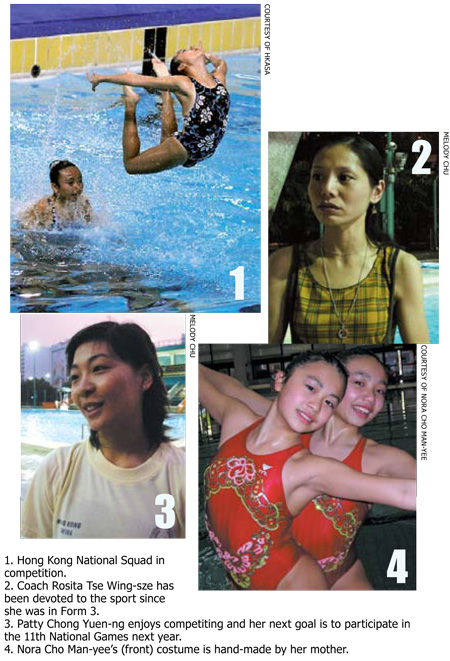
 |
While many were dazzled by the near-perfect performances of the synchronized swimming gold medallists at the Beijing Olympics, few are familiar with this sport. Perhaps even fewer know that Hong Kong also has its National Synchronized Swimming Squad.
The ten-member squad has participated in many domestic and international competitions and won several prizes, such as second runner-up team in the Thailand Open and Age group Champion 2008 this July.
Despite its low visibility, synchronized swimming attracted Patty Chong Yuen-ng, the team leader of the Hong Kong National Synchronized Swimming Squad, due to its unusualness and elegance in both performance and the outlook of the athletes.
Chong, a freshman majoring in government and public administration at the Chinese University of Hong Kong, used to be an ordinary swimmer before she found her passion for synchronized swimming seven years ago.
The 19-year-old has also learned piano and jazz dance before she started professional synchronized swimming training. She then decided to cut down on her other extracurricular activities so that she could concentrate more on synchronized swimming as well as her studies.
"I chose synchronized swimming as it is a combination of gymnastics, swimming and music," said Chong. She thinks that her experience in swimming, piano and dance is helpful to her training in this sport.
Synchronized swimming is also known as "water ballet". Accompanied by music, athletes have to perform a synchronized routine of elaborate moves in the water, which involve arm and leg movements, strokes and body position.
The sport is judged on both its technical merit and artistic impression. It can be performed individually, as a duet or in a team. Only women athletes are eligible for synchronized swimming competitions.
Audiences are always amazed by the athletes' abilities to perform difficult movements like forming special patterns in time to the music, spinning upside down into the water and then jumping out with a somersault like a dolphin.
Demanding strength, gracefulness, flexibility, precise timing and exceptional breath control, synchronized swimming training is tough. Chong thinks that the coordination of different parts of the body and breath control are the most challenging aspects of the sport.
"We (the national squad) are trained to hold our breath under the water for over one minute and ten seconds now," Chong said. "And we have to do it upside down under water to prevent ourselves from floating up to the surface."
The young athletes also suffer from having to do a lot of stretching exercises. "In order to do the splits in the air, we have to do the splits over 180 degrees on the ground," she said.
Participating in both duet and team categories, Chong said she likes team events better. "There are more people in the team performance and it gives greater flexibility. We can form a variety of patterns and lines so that the performance can be much more beautiful."
"When in a team, members of different ages can perform together. It is more fun. The younger girls can learn from the senior members at the same time and it helps the whole team to improve," she added.
The Hong Kong National Squad has trainings four times a week and each session lasts for two to three hours. Chong admitted that the training has affected her studies, but she said the sacrifice was worthy.
"I have developed a strong passion for synchronized swimming. I am devoted to the sport and it has become something I have to do. I would feel uneasy if I could not do it anymore," Chong said.
Responsibility is also another major consideration to Chong. "For me, a sense of responsibility outweighs my personal interest in the sport right now, said the squad leader. "I feel like I have to take care of the junior athletes."
Having a mutual understanding with her partner in a duet, Chong will continue to participate in the sport for the next couple of years, as her next goal is to take part in the 11th National Games next year.
Chong said she enjoys competing, especially at international meets. "When you see other athletes' outstanding performances, you are motivated to work harder."
Though the sport gives Chong a sense of being in an exclusive club, she would rather have the sport becomes popular. "With more people to choose from, the quality of the team will improve," Chong said.
Athletes' outfits and makeup are also important in synchronized swimming. They have to tie their hair in a bun and keep the hair in place with gelatin, a colourless and flavourless gel which does not pollute the water. They also have to wear heavy waterproof makeup so the audience and judges are able to see their faces.
Swimsuits are also important to the sport. The squad used to order swimsuits from stores that made opera costumes in Mainland. To lower the cost, however, squad members or their families, design and make the swimsuits themselves.
Mrs Cho Hui Kit-yi, a parent, helps to make swimsuits for her daughter in the squad. Mrs Cho has made around seven swimsuits over the past two years.
"I finished a swimsuit in one week. I had to stop all my housework for that. The one that I am working on now has taken the longest time ever. I have been working on it for three months already," Mrs Cho said.
"In the beginning, I bought colourful swimsuits and sewed shinny beads on the patterns on the suit. But now, I buy white swimsuits and design my own pattern," said Mrs Cho.
Her 13-year-old daughter, Nora Cho Man-yee, started the sport three years ago and is now a member of the squad. She sometimes gives suggestions to her mother on the design of her swimsuits.
"I fully support her (Nora) doing synchronized swimming as I can see she really likes it," Mrs Cho said.
In addition to designing their swimsuits, the squad members are also involved in choosing the music for their performances.
Each team member can choose four pieces of music, two are fast and two are slow in tempo. The coach will then pick the pieces and design the movements according to the music.
The Youth Synchronized Swimming Promotion Scheme offers the only class for synchronized swimming in Hong Kong and is organized by the Hong Kong Amateur Swimming Association (HKASA) and sponsored by the Leisure and Cultural Services Department.
The Hong Kong National Squad recruits new blood from the class which has a quota of 80 every year. An examination is held every year for students joining the Hong Kong Junior Squad, a preparation team for the national squad.
Poon Ho-ching, 8, was persuaded by her mother to join the class in July. She was then recruited by the Hong Kong Junior Squad, which has ten members, and started the training in September and has classes four times a week.
"Synchronized swimming is something more than swimming," said Poon, who started swimming when she was in kindergarten. She has already known all four styles of swimming.
"I like it (synchronized swimming)," said Poon, the youngest team member of the junior squad. She thinks that the training is not too hard and she enjoys training with her friends.
Rosita Tse Wing-sze, the coach of the Hong Kong National Squad, said synchronized swimming was not limited to children and teenagers. Everyone who can swim 50m continuously is qualified to learn the sport.
"I once had a student who was a 70-year-old lady," said Tse. However, four years ago, HKASA set the age limit of the promotion scheme to six and eighteen.
"We have to focus our resources on training the younger generation. We are trying to make the sport popular among children and teenagers first," Tse explained.
Tse said both the scarcity of resources and people's stress on academic studies has hindered the development of the sport in Hong Kong.
"Talent is very important. A lot more time is needed for training less talented athletes," she said. Tse also said she has seen many talented athletes gave up the sport for the sake of their studies. "It is indeed a waste," said Tse.
